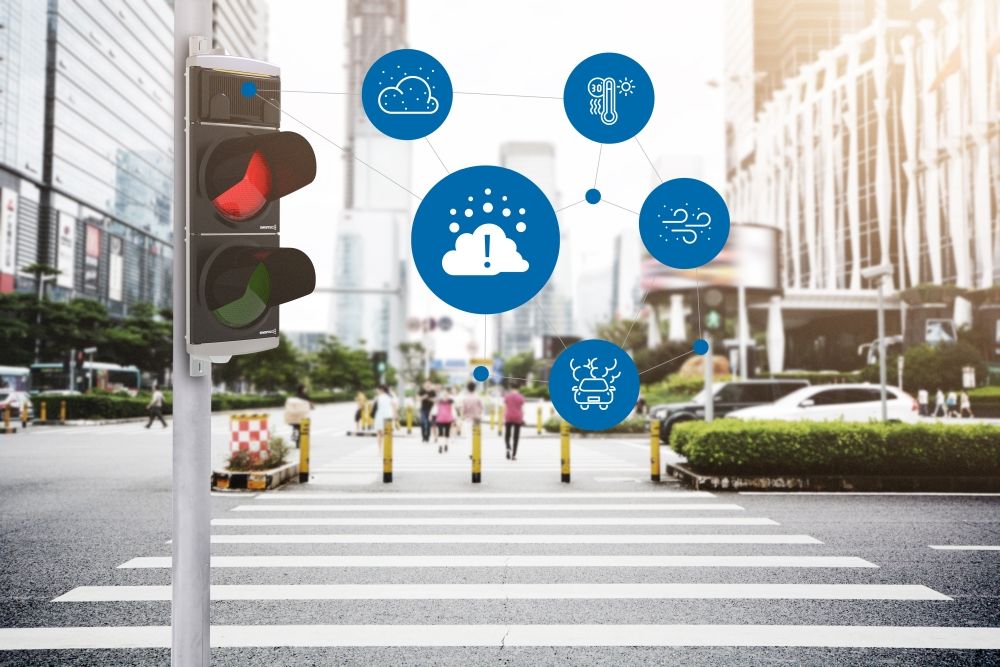Better traffic and hazard management with IoT sensor technology
SWARCO helps infrastructure operators to detect natural hazards earlier and optimise traffic management with sensors and the Internet of Things
Rapidly occurring short-term extreme weather events such as heavy rain, mudslides or wind breakage on roads and railways are becoming more frequent in times of climate change. These weather events pose new challenges for major rail and road infrastructure operators, as they can occur very locally in many places along the infrastructure.
It is often no longer possible to monitor all the hazard areas in advance using natural hazard information maps or it is no longer certain whether existing protective facilities can cope with the increased intensity of the events. Previous solutions in the field of natural hazard detection have mostly been used for selective monitoring in predefined hazard areas using precise sensor technology, designed as an insular system and tailored precisely to the application.
This is where the funded research project NANCI comes in, with the aim of using the Internet of Things (IoT) to develop a self-sufficient, redundant, networked multi-sensor system for the early detection of natural hazards in transport infrastructure. The research project, which will run until the end of 2023, brings together the Austrian transport technology company SWARCO with Software Competence Center Hagenberg GmbH and GeoExpert Research and Planning GmbH and sheds light on how these technologies can be used in combination with established processes and systems to improve and optimise the use of existing systems. The result of the project envisages that a networked and energy self-sufficient sensor network will be set up at field level using camera and radar sensor technology available on the market. The sensor nodes - equipped with edge AI evaluation of the data to anonymise the raw data - are networked via a standard solution. The local logic on site collects and processes the sensor data and sends messages to the existing systems of the Austrian infrastructure operators ÖBB and ASFINAG via an open interface in accordance with the latest data security requirements.
"We have been working on the topic of IoT for years," says Dr Klaus Pollhammer, SWARCO researcher in the areas of innovation and safety. "It all started with the GEMINI project together with the University of Continuing Education Krems, funded from EFRE and by the state of Lower Austria. IoT technologies and sensors form the backbone of a new era in transport. They enable data to be collected and analysed in real time and without local restrictions, leading to a significant improvement in traffic planning and control. Existing processes and systems can be made more efficient with the help of these technologies to ensure a seamless and safer experience for all road users across all modes of transport - from pedestrians to public transport to cars," says Pollhammer.
One crucial aspect is the integration of environmental and hazard aspects into traffic management. By incorporating environmental parameters such as air quality and noise pollution, innovative solutions can be developed that not only optimise traffic flow but also improve the quality of life of citizens. This holistic approach to traffic management opens the door to sustainable and environmentally friendly mobility solutions.
The benefits for infrastructure operators are threefold:
(i) an energy self-sufficient, scalable, modular, safe and open technical prototype in terms of interfaces validated under real-life conditions;
(ii) a cost-effective, publicly procurable, state-of-the-art IoT-based solution;
(iii) a consortium that covers the desired expertise in the project and, through the industrial partner SWARCO, also offers the opportunity to acquire and further develop the solution in the course of a procurement process.
SWARCO is already utilising the advantages of networked sensors by integrating them into traffic lights. The AirDec module measures environmental parameters such as CO, ozone, NOx, heavy rain and noise pollution directly at the intersection and makes this data available to traffic managers via the cloud so that they can trigger short-term strategies for alternative traffic control.
The driver assistance systems of modern vehicles also rely on sensor technology, and this requires well-maintained road markings. In practical tests under a wide range of external conditions, SWARCO has proven that the retroreflectivity and high contrast of road markings are particularly important for them to be reliably "read" by cameras and LiDAR and thus pave the way for automated driving.
Research and innovation projects prove that the future of traffic management depends on close co-operation between technology developers, traffic planners and regulatory authorities. "The combination of new technologies and proven processes will create innovative end-to-end solutions that improve the mobility and safety of all road users and make mobility more sustainable and environmentally friendly," concludes Pollhammer.

sss